1977 Matra Rancho
You probably remember playing with a Rancho toy as a child, but what’s it like to meet (and drive) the real thing?
To boldly go
We’ve only gone and put a Rancho on the front cover
Words: Gavin Braithwaite-Smith
Pictures: Simon Thompson and Magic Car Pics
“It took too long for the motoring world to acknowledge the brilliance of the Rancho. It was a trailblazer, provided you didn’t venture too far down the trail. It was arguably the right car at the wrong time.
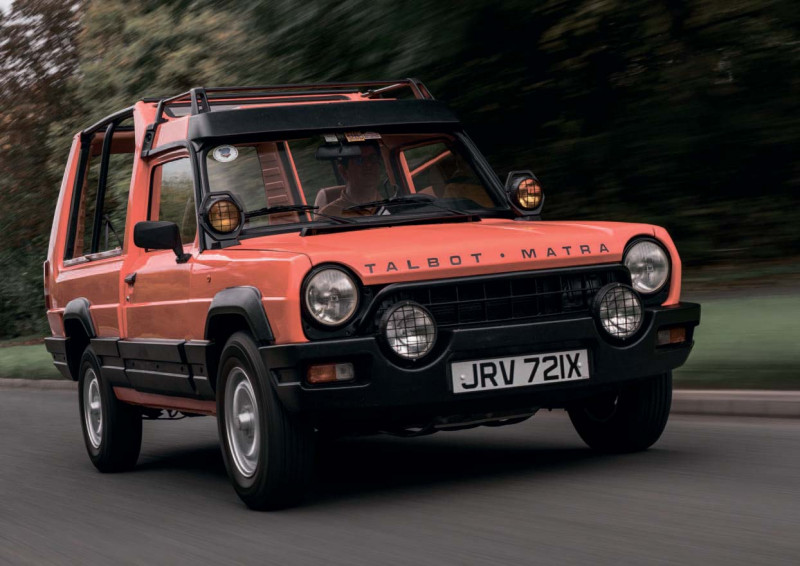
In a parallel universe, Matra is still churning out innovative and trailblazing vehicles. Having successfully diversified into building cars with more than three seats, it became Europe’s pre-eminent manufacturer of soft-roaders and MPVs. Matra is to lifestyle and practicality what Land Rover is to off-roading, and Ferrari is to red supercars. As a profitable business, it has even embraced the restomod culture by churning out dozens of expensive and updated Ranchos for cash-rich 40- and 50-somethings overcome with nostalgia. An opportunity to relive their salad days with a generous helping of Rancho dressing.
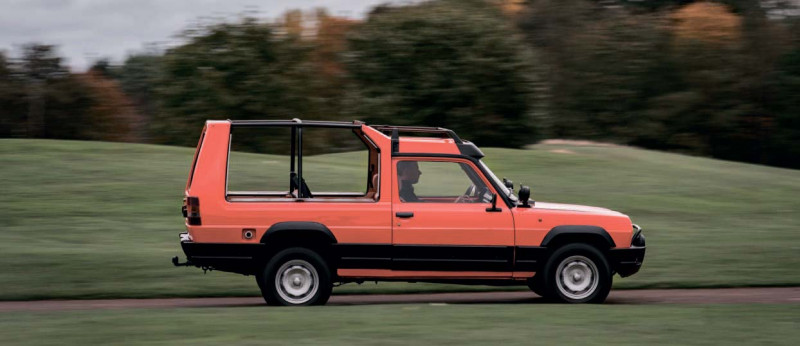
The reality is very different. Matra Automobile, part of the Matra (Mechanique, Aviation et Traction) group, began life producing GRP bodies for the René Bonnet Djet before buying the company and building the Djet under its own name. The mid-engined M530 replaced the Djet in 1967, before the three-seater Bagheera arrived in 1973. The Rancho and Espace should have been Matra’s passport to riches, but when Renault took on the production of the Espace, the company’s fate was sealed. The Romorantin factory was demolished to make way for housing, and the automotive side of the business was consigned to history. This criminally short history of Matra fails to mention its success in motor sport and the development of a V12 engine. Please forgive the hors d’oeuvre nature of this introduction, it’s just that I’m keen to move on to the main course.
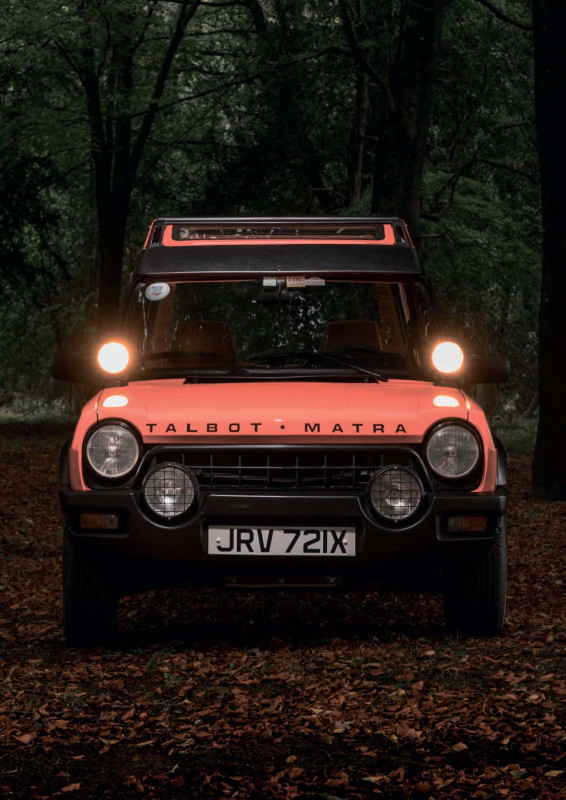
For me, driving a Matra Rancho is like meeting a childhood hero, akin to playing football with Gary Lineker or riding shotgun with Michael Knight. Like many children of the seventies and early eighties, I grew up playing with model Ranchos. My favourite was the Matchbox SuperKings Trans Globe Couriers Rancho, not least for its soft and springy suspension. This made it ideal for dealing with the treacherous terrain of my back garden, while the front crash bar and side mouldings were perfect for tackling skirting boards and the occasional clash with a vacuum cleaner. There can’t have been a toybox in the land without a battered Corgi, Matchbox, Siku or Bburago Rancho. A few even came with something attached to the towbar to tick the lifestyle box: white water dinghy, horsebox, speedboat, even an F1 car. Others were more commercial: ambulance, coastguard, surf rescue, airport fire tender. For the UK’s children, the Rancho was the coolest car on the planet. If pester power could influence the choice of family car, there would have been a Rancho parked on every suburban driveway.
DID you know?The French reportedly sent six Ranchos to Colonel Gaddafi as part of an arms deal. Each car was white with an air-conditioning unit on the roof.
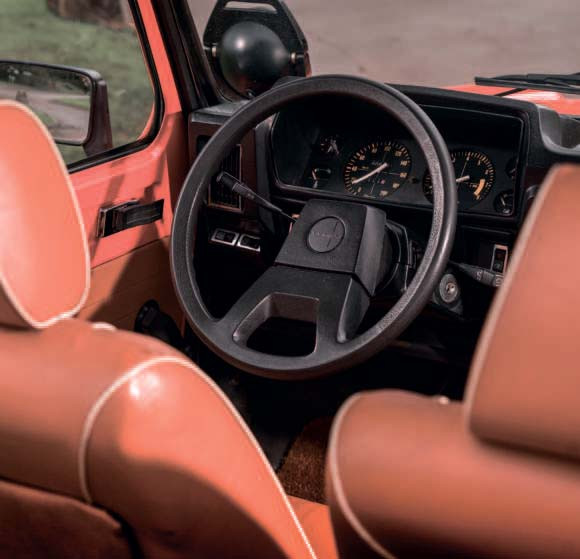
The motoring press needed more convincing. In 1978, the year the Rancho arrived in the UK, Motor argued that some might see it as a ‘...con trick, nothing more than a sheep in wolf’s clothing,’ before concluding that its future would ‘depend on how many people are prepared to pay £5650 for a vehicle that looks the part but can’t quite act it’. It might have looked like an off-roader, but the lack of four-wheel drive meant that it would be fording only the shallowest of streams and climbing only the smallest of mountains. The front-wheel drive Rancho’s go anywhere credentials were questionable, but it blazed the trail for the softroaders of today, and unquestionably inspired the design of the original Land Rover Discovery.
DID you know?Leonid Brezhnev often received a car as a present on state visits to France. On one occasion, he received a Bagheera and a Rancho, but the Soviet President was not pleased with the Rancho’s tan seats and green paint. French officials rushed the vehicle back to Matra where the interior was retrimmed in brown and the bodywork was painted blue.
The story starts in 1973 and the fall in demand for sports cars following the oil crisis. For Matra, a company which relied on the Bagheera, this posed a problem, so it started looking at alternatives. Inspiration came in the unlikely form of the Simca 1200 Campero, a Spanish-built vehicle built by a Chrysler dealer for unmade roads. Separate interest from Chrysler France led to a meeting of minds, and a decision was made to build a car with the styling of a Range Rover, the practicality of an estate car, but the running costs of a family saloon or hatchback. It was, if you like, the first proper ‘crossover’, although few people use this rather nebulous term in everyday conversation.
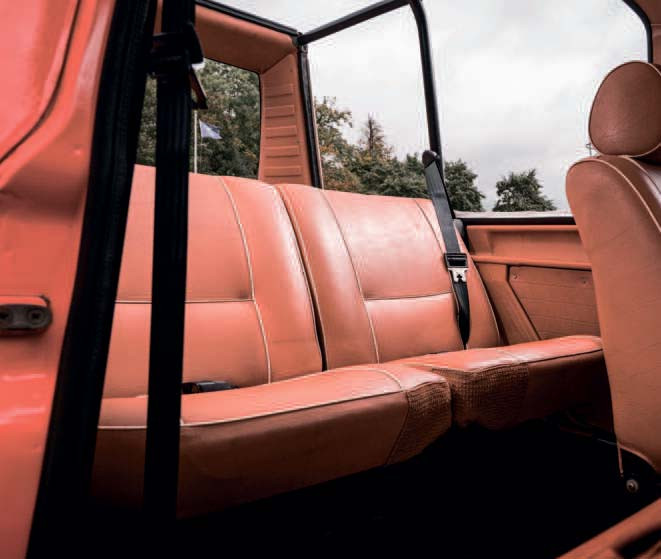
To keep production costs to a minimum, the Rancho used the 1442cc transverse engine and four-speed gearbox from a Chrysler Alpine, with a lengthened and strengthened floorpan, plus torsion bar front and rear suspension from a Simca 1100 pick-up. The steel front end looked not too dissimilar to the Simca, albeit with a macho-Rancho makeover, while the rear section was glassfibre mounted on a steel frame. The UK market hadn’t seen anything quite like it, although vehicles like the Citroën Méhari and Renault Rodeo helped to reduce the element of shock across the Channel.
Imagine walking into one of the 650 Chrysler showrooms in 1978, and seeing the Rancho parked alongside the Horizon, Avenger and Alpine. Sensibly, the importers decided to give it a Matra rather than a Matra-Simca badge, in fear of Simca’s reputation for rust harming UK sales of this European space oddity. Later, following Peugeot’s takeover of Chrysler Europe, UK cars would adopt the Talbot-Matra name, but there was never a reference to Simca. Mounting the letters on the edge of the bonnet was a deliberate nod to the Range Rover; Matra saw the success of the go-anywhere vehicle and wanted a slice of the action. It was also aware that while the Range Rover could certainly walk the rugged walk, many buyers simply wanted to talk the rugged talk.
‘The Rancho has become a very fashionable car in which to be seen along the boulevards of Paris,’ Chrysler admitted, as if to downplay the vehicle’s rural capabilities. ‘Matra Rancho. For people who don’t mind being noticed a little,’ the press ad said, complete with a photo of the car parked outside Harrods. To ram home the lifestyle message, the UK marketing team stuck a Chrysler outboard engine in the boot and sent a red Rancho to Chichester yacht basin for a photoshoot. ‘Take a test drive in a Rancho. It combines specialist vehicle performance, estate versatility and saloon comfort into an exciting new way of motoring. Spread your wings with something really distinctive – Rancho,’ the brochure read.
To ensure the Rancho would fly out of showrooms, the importers lavished the UK’s single model line with kitchen sink-levels of equipment. All cars came with wing-mounted movable lights ‘for when the going’s rough’, although the fact that they could be operated only with the engine switched off meant that they wouldn’t be of use during OMD (off-road manoeuvres in the dark). As Billy Ocean probably found out, when the going got tough, you’d still need a proper 4x4, although the standard-fit sump guard came in handy if you attempted to follow the Range Rover set a little too literally by venturing too far off the beaten track.
Of the 56,792 Ranchos built between 1977 and 1983, around 6000 found homes in the UK. That’s around 10% of production, which is a decent result for a car without a segment and with little to no brand equity. The Matra name was alien to most Chrysler and Simca buyers, and although the Talbot badge delivered some familiarity, the Rancho still looked out of place alongside the Sunbeam, Horizon, Solara and Alpine.
Even the Tagora, today’s forbidden fruit of the saloon car world, looked relatively normal alongside the Rancho. Members of the press didn’t like it because they couldn’t pigeonhole it; cheaper but less effective than a Range Rover, Jeep Cherokee or Chevy Blazer, and the same price as the more practical Citroën CX 2400S, Volvo 245 DL and Ford Granada 2.3L estates. That said, an initially sceptical CAR did warm to the ‘boulevard battlewagon’ after 36,000 miles. In a 1980 summary, it made the following observations: ‘Admirable transport for the specialised use to which it was put.
Very few problems or faults and the bodywork, well protected all round, is in excellent shape. Comfortable and quite quick for long distances, and fairly frugal with it. Maintenance costs low. Limited off-road capability, but better than most ordinary estates because of good ground clearance and sump-guard protection. Very well equipped, unexpectedly durable and usefully versatile provided you don’t need to carry very heavy loads, for which the relatively soft suspension is unsuited. Modest price increase since UK introduction makes it much better value now than it was. Not just a pretty face: it’s capable of working hard and well for its living.’ Take that, sceptical motoring journalists. Clive Nelson of the Matra Enthusiasts’ Club bought a nearly-new Rancho from a Peugeot-Talbot dealer in 1981. He said the salesman had no information on the car and couldn’t even tell him where it was built. Having asked the sales guy if he could add any accessories, he was told he ‘might be able to find a set of mud flaps’. Personalisation options were thin on the ground, but caravan mirrors, roof rack, sand ramps, wind deflectors and a ski rack were some of the accessories available, if the dealer knew where to look.
Aside from a facelift in 1981, which included the fitment of a new carburettor, electronic ignition, revised door mirrors, new colours and interior trim, and standardised rear-facing child seats, the Rancho was left to its own devices in the UK. Chrysler and Peugeot- Talbot relied on press advertising and word of mouth to spread the word, although the Rancho’s role as the lead car in the 1981 London Marathon wouldn’t have done it any harm. There was also the thousands of miniature Ranchos in active service on the living room floors of the UK, although by the time the children had grown up, most of the full-size versions had already rusted away. Corrosion was the Rancho’s nemesis, with the wing-mounted spotlights creating their own rust traps. For years, the Rancho was derided by the nation’s motoring writers, who failed to spot the car’s influence on the modern breed of lifestyle vehicles.
Writing in 2010, Andrew English said the Rancho wasn’t the designer’s ‘finest hour’, pointing to the Renault Espace, Citroën Xsara Picasso and Matra Bagheera as some of Antonis Volanis’ better efforts. It’s a ‘front-drive 4x4 lookalike for impecunious Range Rover wannabes’, he slammed, although he did concede that it was ‘ahead of its time and quite popular’. Unfortunately, the UK was robbed of some of the most interesting variants. The AS (affairs & sociétés) was a commercial version for Rancho owners who meant business, while the X was a ‘luxury’ model boasting the likes of alloy wheels, thick carpets, tinted windows, metallic paint and plush seats. Peak Rancho, however, was the Grand Raid, a model that could take you to places other Ranchos couldn’t reach. Limitedslip differential (called anti-bog), an electronic winch, off-road wheels and tyres, roof-mounted steering wheel, towbar and wing-mounted spotlights – this was the Rancho of your childhood dreams. There was even a Découvrable for sunnier climes (if not climbs). Just 600 were built, most of them ending up on the Mediterranean coast. Matra toyed with the idea of a proper 4x4 version and considered fitting a fuel-injected 1.6-litre petrol engine, but these never came to fruition. Instead, it lived on until 1983, its life extended by two years to allow Matra to perfect Project Orange (the Espace) for its new partner Renault. The Rancho production line was stripped down during the Christmas shutdown of 1983; it was time for The Great Espace.
It took too long for the motoring world to acknowledge the brilliance of the Rancho. A genuine trailblazer, provided you didn’t venture too far down the trail, it was arguably the right car at the wrong time. The world and its wife wanted a soft-roader, they just didn’t know it yet. Clive reckons 200-300 Ranchos have survived apathy and terminal corrosion, but UK numbers are probably down to single figures. I won’t ask you to get down on your knees to worship at its altar, but there are 200 Corgi Ranchos for sale on eBay if you fancy getting on your knees to push one along the living room floor. You know, just for old times’ sake.
Driving the Matra Rancho Decouvrable
Peter Brownrigg owns the only Rancho Découvrable in the UK. It’s immaculate. Fully restored. Better than when it left the factory. A priceless classic. I sense a little trepidation as Peter hands me the keys to his unicorn. “I’m covered for up to £80,000,” I reassure him, forgetting that it’s impossible to replace the irreplaceable. It doesn’t help that I’m so nervous my hands are shaking as I twist the key in the ignition. I’ve waited most of my life to drive a Rancho; the last time I was even close to one was at a used car lot in the 1980s. I looked up at it in wonder from the seat of my Original Kettcar, in awe of its Tonka-like styling and swivelling headlights. I pleaded with my dad to buy it, but he muttered something along the lines of getting home before lunch was cold, and that was that. Like Wagon Wheels and Creme Eggs, the Rancho isn’t as large as I remember. A width of 1665mm and height of 1735mm means it’s about as tall and wide as the most recent Suzuki Jimny, although the length extends to 4315mm, which is more like the Suzuki SX4 S-Cross. Park a Rancho alongside the latest Range Rover and it’ll look like a tender for a superyacht.
The Découvrable was closer in spirit to cars like the Jeep Wrangler, Citroën Méhari and Renault Rodeo than the rest of the Rancho range; vehicles for high days and holidays in the sun. Launched in 1981, it featured canvas sides to the rear and in place of the upper section of the tailgate. These could be rolled up or removed if you trusted the weather forecast. Vinyl seats were fitted in place of cloth, just in case Michael Fish’s Mediterranean cousin failed to predict the arrival of a hurricane. A viewing window was fitted above the rear seats, with the Range Rover-style drop-down tailgate remaining in place. Aside from that, it’s standard Rancho.
Not that there’s anything standard about Peter’s Découvrable. Take the colour, which is – and I’m not making this up – Deutsche Reichsbahn orange. It wears it well; you have to question why Matra offered the Découvrable in any colour you like provided it was green or clay. Brighter colours would have been brilliant. The Mille Miglia light alloy wheels and six-dial instrument panel aren’t standard, while the radio has been replaced by a more modern unit. The aftermarket Amstrad speakers are a nod to the past and get in the way when you’re using the window winders. First world problems and all that. I spend time taking in all the minor details, like the S.E.V Marchal headlights, Talbot filler cap and the wing-mounted spotlights. A tweak made to the wiring during the car’s restoration means the lights can be used when the engine is running. The perfect riposte to oncoming, retina-burning LED daytime running lights? The rear lights are unique to the Rancho and command a premium on the spares market. I wish Matra had the foresight to offer Land Rover-style light guards as an option…
Right, it’s time to go for a drive. I must remember to avoid hitting skirting boards, the cat and mum’s vacuum cleaner as I take to the road. Engaging the first of the four gears, I lift the clutch and… stall it. Then I stall it again. Peter smiles, but inside his heart is probably breaking. I don’t remember having to feather the throttle to maintain a smooth idle when pushing a Rancho along the carpet. Things improve once the Simca engine has warmed up and my legs stop trembling. It was a nervous tremble, I promise, and nothing to do with the fact that Peter had removed the canvas panels for the photo shoot. Who needs a roof on a cold October day in Wiltshire? Mediterranean sunshine is so over-rated.
It’s not an easy car to drive around town. The ride quality is less comfortable than the Matchbox SuperKings version led me to believe, the unassisted steering is bicep-building heavy, the gear change is imprecise and any hopes of starting a conversation with Simon the photographer are thwarted by the engine noise and the fact that we’re essentially piloting an open-sided marquee. A standard Rancho is likely to be more refined and civilised, but I’m beginning to wonder if it’s a classic case of never meeting your heroes.
Things improve once you leave the urban sprawl. The 1442cc engine produces a healthy 80 chevaux, which is more than enough for a car weighing, in tin-top form, 1148kg. It means that you can hustle it along at a decent lick, although I don’t fancy hitting the 91mph top speed or putting my faith in the brakes (Simca 1100 Ti discs at the front, drums at the rear). Speeds of between 35mph and 50mph are its comfort zone, quite literally, because the ride quality is very French on an open road. That’s high praise when you remember that it’s essentially a Simca pick-up in lifestyle clothing. Today’s crossovers and SUVs tend to be based on existing hatchbacks and saloons, whereas the Rancho’s roots were more rudimentary. It hides them as well as a Citroën Berlingo or Renault Kangoo. There’s a hint of authentic French body roll when cornering, but I don’t push it too hard; it’s not that kind of vehicle.
Visibility is great, aided by the absence of bodywork behind you and the relatively high driving position; the Rancho boasts six inches of ground clearance. Only two gears are required: second for pulling away and fourth for everything else. The less time spent changing gear the better. It’s not a car for going fast; it’s more suited to taking life at a more Mediterranean pace, never allowing the bouncing needle on the Veglia speedo get above 80km/h.
Above all else, it’s fun. Peering over the bonnet, my view of the road flanked by a pair of spotlights, it couldn’t fail to put a smile on my face. Not fun to drive in a traditional sense, you understand, but for a company with no experience beyond sports cars, it’s a brilliant first effort. It paved the way for the Renault Espace, which means Matra can lay claim to pioneering not one, but two popular segments. My parallel universe sounds a lot better than the reality.
If I spent my days flitting from café to café on the Brittany coast, I’d have a Rancho in a heartbeat, but I prefer to remember the Rancho as my childhood hero. The best car in the toybox and the coolest vehicle my father never bought. Still, we got home before our lunch went cold.
Thanks to Peter Brownrigg for my chance to meet a childhood hero and to Clive Nelson of the Matra Enthusiasts’ Club UK for his unrivalled knowledge of the Rancho. matra-club.net Location photography: Bowood Hotel, Spa & Golf Resort (bowood.org).


